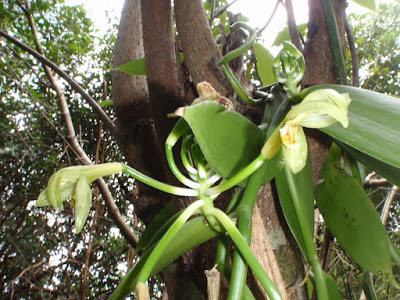This fellow visited our garden this week. Officially known as a panther chameleon (Furcifer pardalis) in English, locally it's called an endormi due to its slow way of walking. Native to eastern and northern Madagascar it was introduced to Reunion (and Mauritius).
 |
| Panther chameleon/endormi |
Its generic name Furcifer is derived from the Latin root furci meaning "forked" and refers to the shape of the animal's feet. Male panther chameleons like this one can grow up to 51 cm (20 inches) in length, with a typical length of around 43 cm (17 inches). Females are smaller, at about half the size. Panther chameleons have very long tongues (sometimes longer than their own body length) which they are capable of rapidly extending out of the mouth. They spend the majority of their life (about three to five or six years) in isolation, apart from mating sessions.
 |
| Panther chameleon/endormi |
Incidentally I saw this other visitor on the terrace this time last year:
 |
| blind snake |
It's a nonvenomous blind snake (Reunion doesn't have any venomous snakes), probably a Indotyphlops braminus. The others species found on the island is the Indian wolf snake, Lycodon aulicus.
Update:
On August 10th 2018 when we got back from travelling in Norway we found this fellow at the entry to our shed. I don't know how long blind snakes can live, so I've no idea if it's the same one as last year or a relative ;-)
Further reading:
Update:
On August 10th 2018 when we got back from travelling in Norway we found this fellow at the entry to our shed. I don't know how long blind snakes can live, so I've no idea if it's the same one as last year or a relative ;-)
Further reading:






